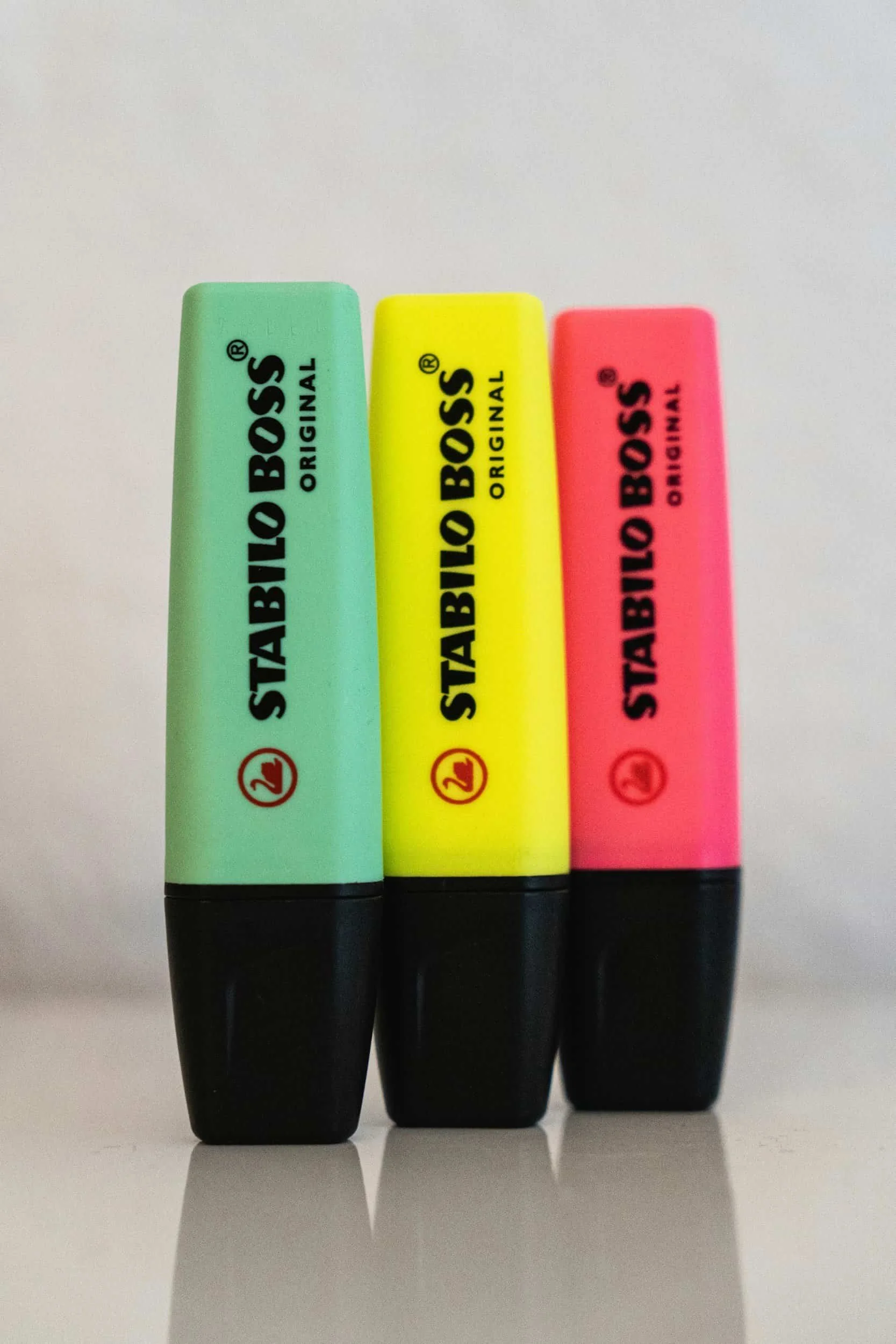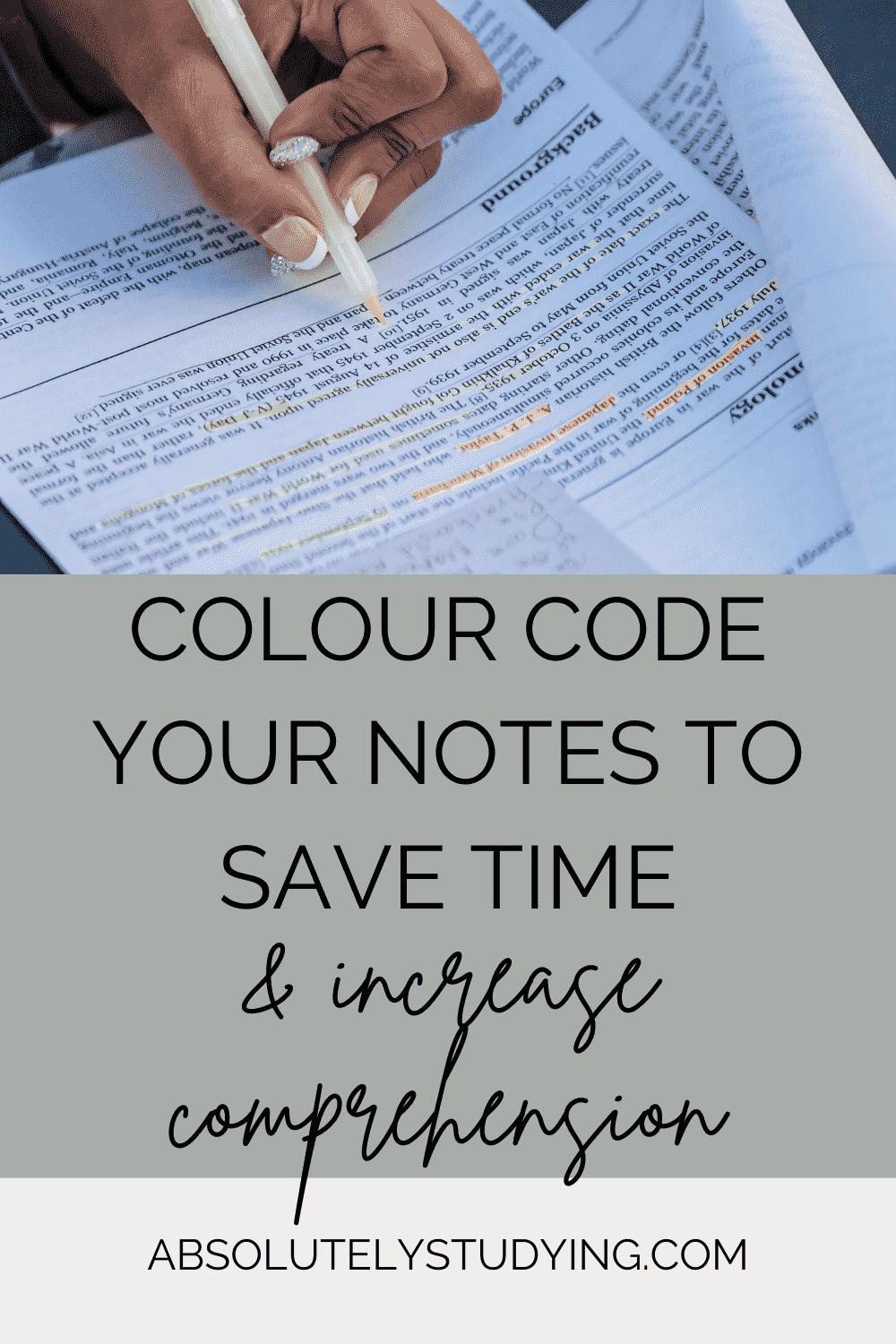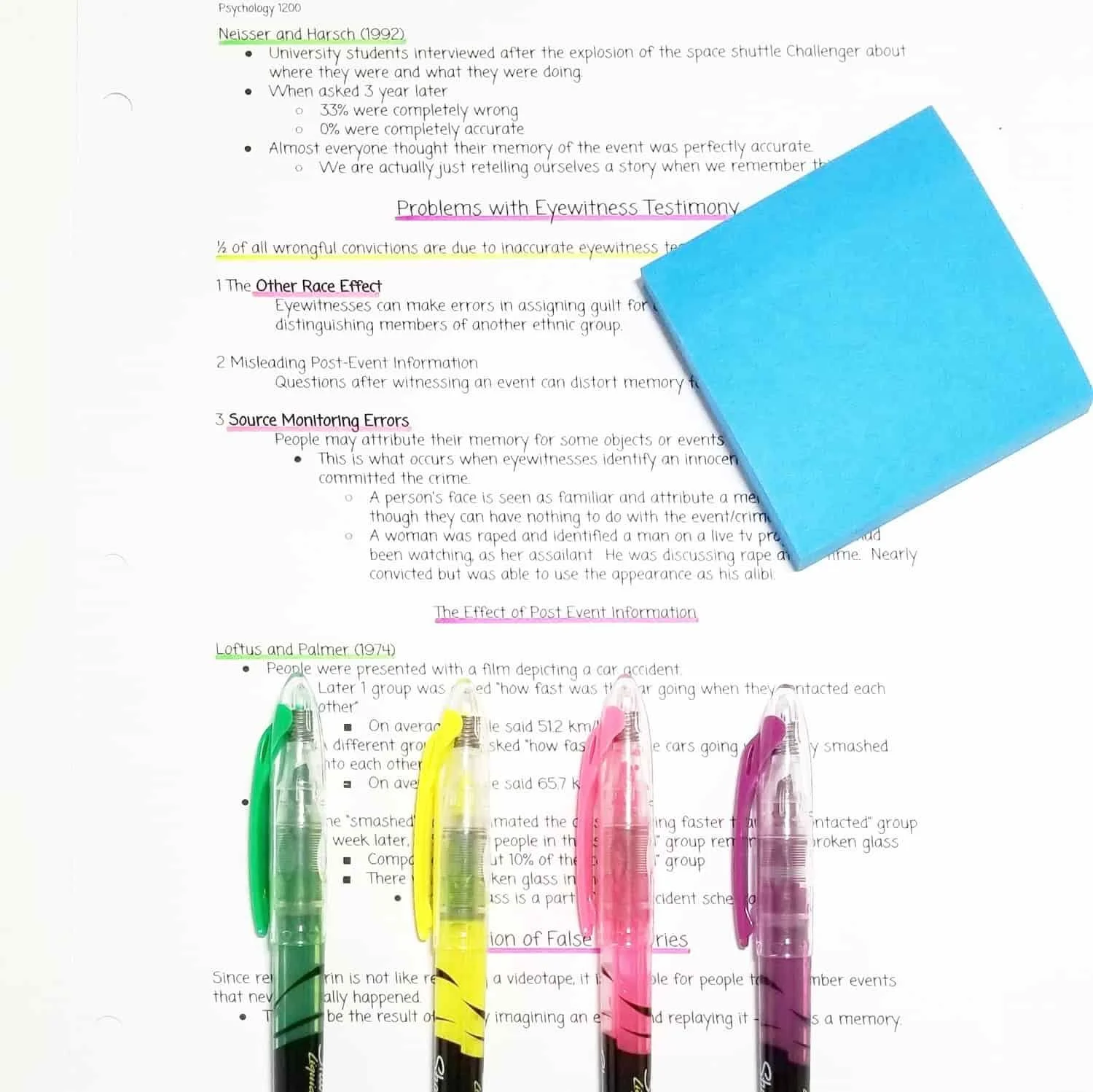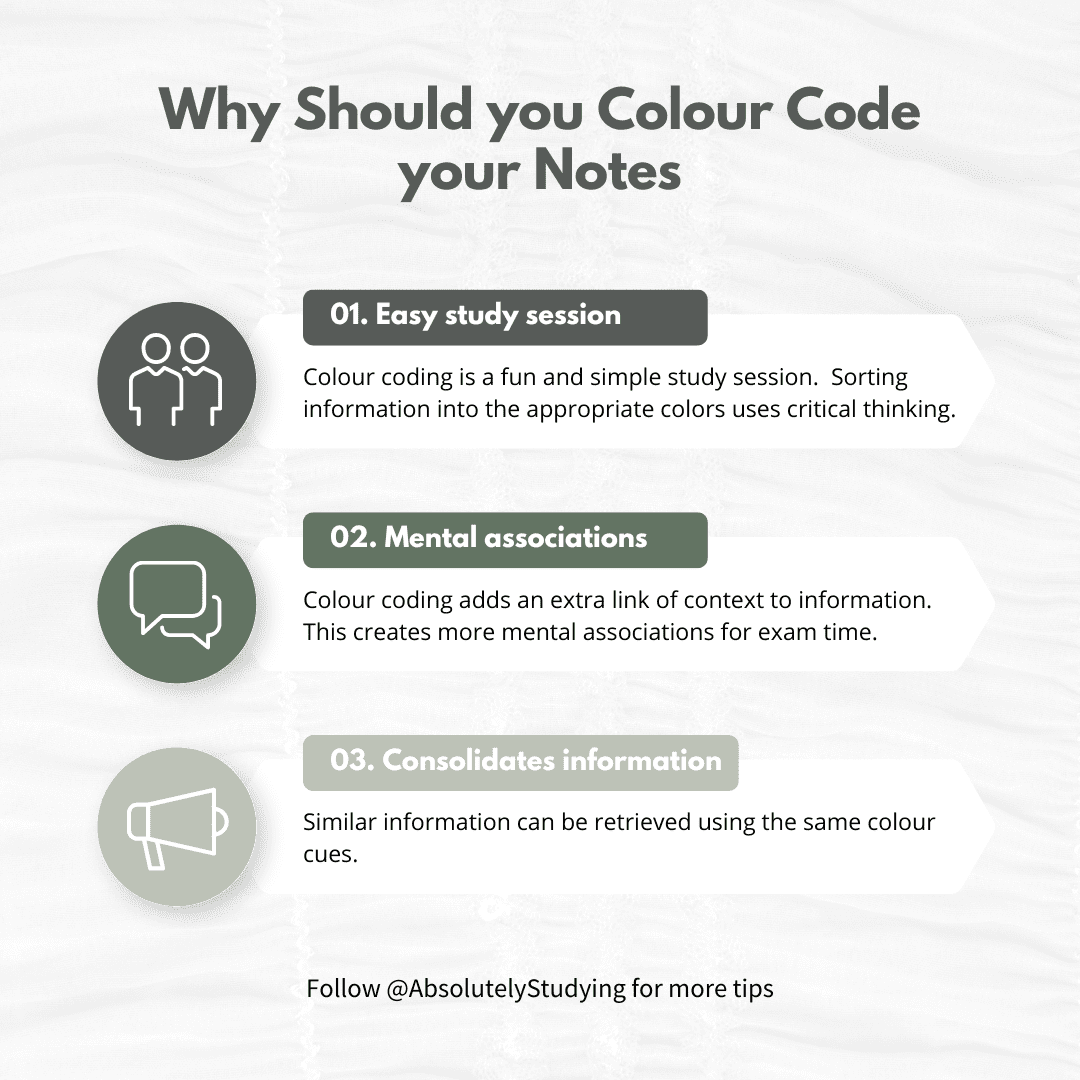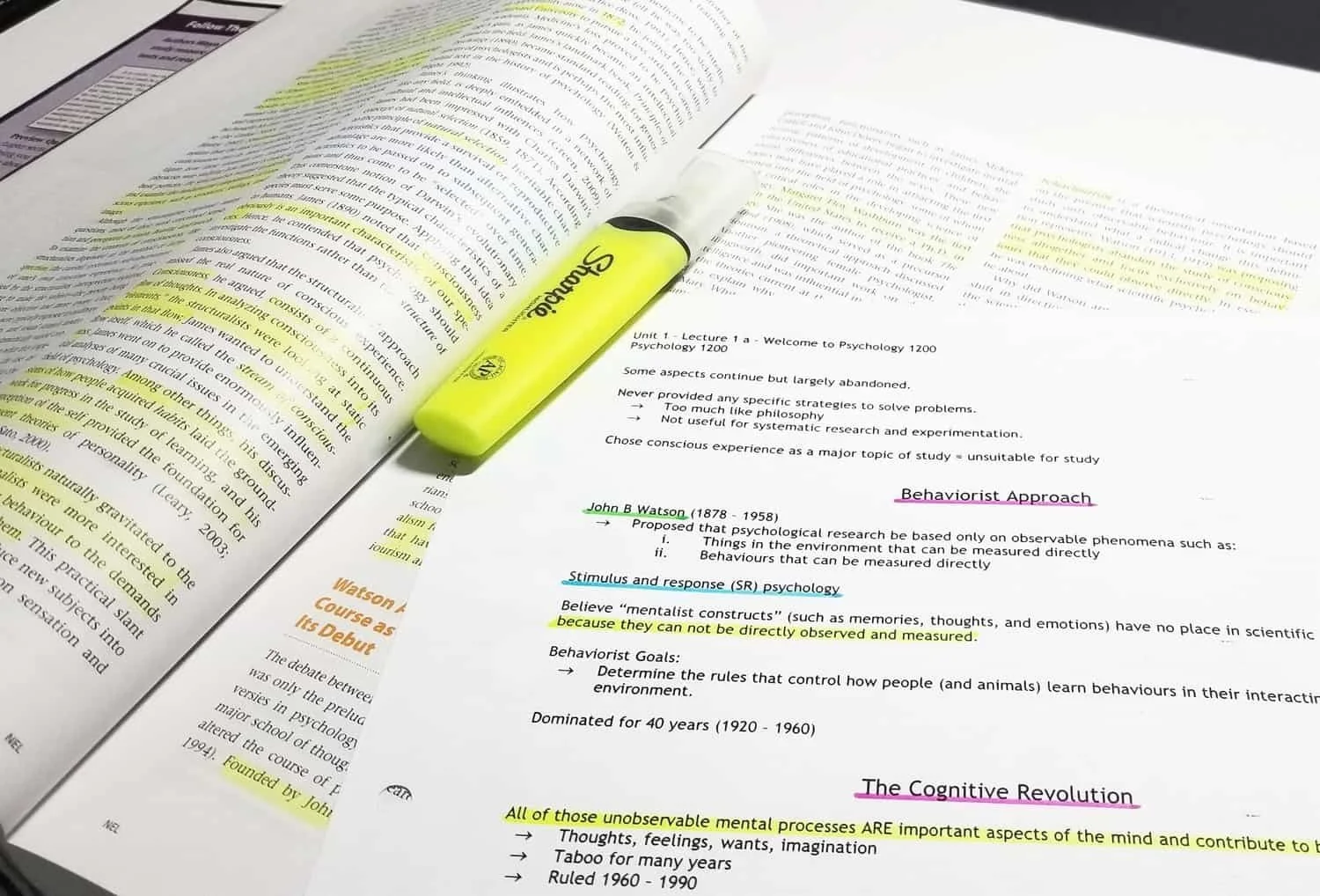How to Use Colour-Coding to Study Smarter
How to Use Colour-Coding to Make Studying Easier & More Effective
Use this simple highlighting trick to organize you notes and increase your understanding.
Everything you need for the semester you want!
This bundle includes:
The Syllabus Study Planner
The Pomodoro Planner
A Confidence Tracker
A Q&A planner
The “Get Organized Checklist”
and more!
This workbook is full of super useful resources that can be applied to every aspect of your day.
* Disclaimer * Some of the posted links are affiliate programs. By clicking these links, I may receive monetary compensation. This will not alter the price or change the buyer's experience.
Highlighting my notes is one study strategy I have found myself completely dependent on. It’s amazingly simple and can be effortlessly added to any study plan. I use the highlighting trick as a separate and intentional study activity.
Rather than multi-tasking and doing it as I create or consolidate my notes, I have two separate highlighting sessions. The first is when I read my textbook. I will apply this technique during my read-through after I have skimmed it thoroughly. The second time I used this colour coding strategy was in my final notes. This is after compiling what I have pulled from the textbook, the scribblings I made during class, and any other research I’ve done on the topic.
Colour coding notes helps to streamline how you access the information. With just one glance, you get the immediate organization and context of the data. When searching through a subject for a reference, it is so much easier to just glance at a sentence and get the context before you even have to read it. It helps you to study more efficiently and to push through the mounds of facts coming at you from every direction.
If you struggle with your study sessions, download my free study planner and activity tracker. They will help you create a study strategy that suits your learning style and organizes your efforts. Use these templates to create a study guide just for you, and you can make a plan to improve your study habits and decrease stress! Download it for free here.
DOWNLOAD NOW: FREE STUDY PLANNER & ACTIVITY TRACKER
Get your study guide template!
Everything you need for the semester you want!
What is Colour-Coding, and Why Does it Matter?
Colour coding is an organizational system that uses coloured cues to classify information. Each colour is assigned to a specific type of information, allowing you to quickly sort through pages of notes at a glance. This strategy will help you keep your notes more organized and find the information you’re looking for more efficiently.
The colour coding strategy can be applied to any of your sessions as a study activity. It can benefit you by having an active, intentional task to complete while reviewing your notes, making it more likely you will retain the information. It will also help to classify the data in your memory, creating more mental associations than reading alone. It also helps to organize the information for retrieval and reference.
These benefits help to lock in the information for better retention and recall. The more activities you do with a particular piece of information, the more likely you are to remember it when you need it most. These activities will help you create more mental associations, which develop a web of cues leading back to the concept for easier recall.
How to Colour-Code your Notes
Colour-coding your notes can be an independent study activity. I like to do it after I have compiled my notes, read through them, and check that they make sense and are complete.
I often dedicate a Pomodoro study block specifically to this task. By planning activities for each block, I can ensure that I break up my work into simple steps, helping me stay focused. If I concentrate on a single task during that study block, I can devote my full attention to it, ensuring I absorb as much information as possible.
Breaking up and rotating study sessions like this also ensures that I complete each item on my study planner and use my time as efficiently as possible.
Assign certain colours for specific meanings.
Having a standardized set of colours is crucial. This will train your brain to immediately recognize context when reviewing all your notes later. When choosing your colours, be sure to assign each one to a specific type of information.
I often like to stylize my notes, so I sometimes will use different shades, but the actual colour will always stay the same:
Yellow = Important points
Pink = Vocabulary
Green = Names, dates, or places
Blue = Theories and hypotheses
Orange = Point of view
Red = Critical (very rare)
Not only do I use this method in my notes, but I also use it in my textbooks. I like to read through my textbook before pulling notes from it, and when I do, I apply the same highlighting tactics.
In my first read-through, I only highlighted important information. I usually do this before the class to understand the concept before the instructor discusses it. By doing this, I will already have an idea of what I find confusing and pay extra attention if needed. I will also be able to find out what information the instructor stresses so I can take care to pull notes on these concepts.
I take notes when I scan or read the passage a second time. Splitting my reading into tasks helps me easily identify things I originally considered important. On a second pass, I can decide if this is something I want to immortalize in my notes. It also makes it easier to go back and find specific details I know I want to elaborate on further. I can quickly flip through without having to skim entire pages looking for things like names, dates, or theories, which are often not emboldened in textbooks.
Keep a table of colours at the front of your book and in your study space.
Everyone has those moments when they space out and can’t remember even the most common routines. Keeping a quick key at the front of our books, especially when we first incorporate colour coding into our routines, will help us stay consistent.
Even now, I often refer to my key for some colours I don’t use very often. It will often slip my mind if I have assigned blue for important dates or Green. Regardless of how long I use this colour coding practice, I still have to check sometimes.
Always having that key accessible will make it easier to stick to and less likely to stray, causing confusion later. I keep the key in the front of my planner and a second one on the corkboard above my desk. You wouldn’t want half of your vocabulary in pink and the rest in orange. It might be overlooked once your eyes get trained!
Keep these colours consistent across all your classes and subjects.
Once you have committed to a colour coding scheme, lock it in for your entire academic career. These colours will turn into a language that can convey information without a single word. Keeping the colours consistent will be necessary, especially when reviewing past notes.
With the colour coding key I had developed, each indicator had enough flexibility to be used across the various classes I had to take. Regardless of the discipline, I knew what the information would mean before I read the actual words. I could use the same colour coding codes for Calculus, French, Psychology, etc.
Sometimes I would experiment with different shades or hues of colours. This way, I could switch up the style and feel of my notes while still staying true to the key. It also helps to satisfy my love for stationery by experimenting with different highlighter brands and pens.
Don’t use too many colours!
The more you add, the more additional information you have to remember. Try to keep the colours down to about 4 or 5 so you don’t bombard yourself with an overflow of rainbow brightness. There will be a couple that you use regularly.
The most popular colour I used was pink for vocabulary. Yellow was close behind for essential points. Blue was third when I had important rules, laws, theories and hypotheses that I needed to memorize. Finally, green was fourth for names, places and dates. However, this varied for different classes, but I could always fit most of my colour coding into these categories.
I admit to having six colours in my key, but red and orange were used very sparingly. I use red exceptionally rarely. I will often limit it to when the professor says, “This will be on your exam,” and then I will usually add a red box around the paragraph. I will also box in a segment of my notes if it is something that I keep forgetting. Red is my “Hail Mary.”
Orange was another colour that I rarely used but liked to keep track of. Since I was a science major, I was often introduced to the opinions or thoughts of the professor and past scientific icons. I liked to keep track of these to see how hypotheses developed over the years. Even though these initial assumptions were not theories, I found them helpful in remembering the resulting findings, which helped me to recall them better.
Colour-code your notes when reading your textbook.
I follow a seven-step process for reading my textbook and preparing for classes. Each step helps me better understand and retain the information the first time I read it. This strategy is also designed to be divided into several Pomodoro Blocks, so I can manage my time effectively and take regular breaks.
The step where I actually read my textbook is done before class. This primes me for what I will learn and helps me to retain the information better. When I know what the instructor will discuss, I can ask better questions and take more intentional notes. I can also focus on small details between how the professor explains a topic and how it was presented in the textbook.
I apply my colour coding strategy directly to the pages when reading the textbook. I will make sure to highlight any new words and terminology. I also watch out for essential points, dates, and names. Etc. When I highlight the text instead of taking notes, I can still indicate any critical information I need to save for later. It also speeds up the reading process since I don’t have to write my notes.
Later, when I rewrite my lecture notes, I will cross-reference with the textbook and add any missing details. This way, I am not missing out on any information from the class or the text, and I’m not needlessly pulling notes from everywhere. It also saves me the time of having to do an exhaustive read-through or search of the textbook to find important information because I have already highlighted it.
Colour-code your class notes when reviewing them, not when writing them.
I know this step is hard, especially when you love having organized and aesthetically pleasing notes like me. I like my notes to be complete when I step away from a study session, so leaving my page so bland is incredibly painful. However, this study strategy has a method, and each step is deliberate.
Colour coding is used to help cement the facts into your brain. This process is better served when you are reviewing your notes. By writing the information down, you are already classifying it as somewhat necessary. Colour coding organizes all of that information, and this is better done on review.
I try to consolidate my notes the evening of class, then review and highlight them the following day. During this step, I will rewrite my lecture notes and supplement them with notes from the textbook. This allows me to see what I forgot in the few hours since class. When reviewing and highlighting them the next day, I can reassess what concepts I have trouble remembering.
Information deteriorates quickly, whether you realize it at the time or not. The more occasions you schedule to review and re-invite the concepts into your memory, the more likely it is to stick around until test time. Studying and working with your notes repeatedly will give you the best setup to remember and recall everything you need during test time.
Highlighting helps to streamline other study activities.
Once you have highlighted your notes, most of the essential information will jump out at you. Because it is earmarked for reference, it stands out on the page. The colours stand out, and you know exactly what areas of your notes are most important. You can think of this as a heatmap of relevance. Since you have already pointed all these concepts out, skimming through and pulling the information you need will be easier and faster.
When you go on to create more study activities like flash cards or practice exams, you can already glance at the page and know what to add. These colourful indicators are the first place to start. If you are creating study supplementals and don’t include each of these highlighted sentences, you are doing yourself a huge disservice.
As you pull these important facts, make sure to reword them in several different ways. This will have you thinking of the concepts from different angles to prepare you for the upcoming questions during exam time. If you are making practice quizzes, be sure to create several different types of questions for each. These include multiple choice, short answer, long answer, diagrams, etc. You can even try making up some trick questions! Get into the professor’s mind, so you don’t get caught off guard!
Only have time for a quick review? Highlighting is the method for you!
Sometimes, 10 or 15 minutes is all we have to fit in a quick look-through before class starts or wait on the bus. It is nice to get down to the nitty-gritty and review one aspect of the information. Flipping through your notes to check vocabulary or influential people is a nice reprieve from a deep dive into some topics.
Glancing through your notebook for pink or green can make you feel a sense of accomplishment by being able to cover more material and flip through the book faster than reading word for word. You can also test yourself using this same method. Simply skim through for the desired colour cue and then quiz yourself on the adjacent information.
Unleash your Creativity and Have fun with Colours!
There are so many tools beyond the classical highlighter that you can use to spice up your notes. Try adding coloured sticky notes to add new information to old notes. Use pens, pencils, and markers to add some flair! Stylize essential words or phrases and make your notes fun to review and write.
There are so many different ways to apply this study activity. You can personalize the colours or styles to suit your aesthetic. I love changing my notes’ look and theme with the topics discussed in class. It’s true that it takes extra time to do this, but you are spending that time focused on the concepts, which creates more mental associations for you to rely on during test time.
Study Skills Digital Course
Learn how to create a stress-free comprehensive strategy!
Sometimes fun study activities are found where you least expect them. We are trained to believe that if you are having fun, somehow, what you are doing is not beneficial. We are told that studying is boring and that you have to dread it for it to be effective.
Colour-coding your notes is a simple and creative outlet that allows you to personalize your notes and create meaningful cues to help you remember. This task can be enjoyable, especially since you are doing something that allows for some colour!
Unlock the Power of Your Mind with the How to Manifest Good Grades Workbook
Are you ready to transform your academic journey and achieve the grades you've always dreamed of? Then, let me introduce the 'How to Manifest Good Grades' Workbook. Your ultimate guide to unlocking academic success through the power of positive thinking and goal setting.
The How to Manifest Good Grades Workbook is more than just a study aid; it's a comprehensive tool designed to help you harness the power of manifestation and positive visualization to achieve your academic goals. With this workbook, you're not just studying smarter; you're cultivating a mindset primed for success.
This workbook walks you through a practical 7-step method for manifesting better grades. Learn more.
What’s Inside:
Goal Setting Techniques: Learn how to set realistic, achievable goals that will guide you toward academic excellence.
Manifestation Strategies: Discover proven manifestation techniques that will help you align your energy and focus on your educational aspirations.
Visualization Exercises: Engage in powerful visualization exercises that will help you see and feel your success, enhancing your motivation and confidence.
Positive Affirmations: Access a curated list of positive affirmations tailored to reinforce your academic goals and maintain a success-oriented mindset.
Actionable Steps: Find actionable steps that bridge the gap between your current reality and your academic ambitions, turning dreams into achievable objectives.
Transform Your Study Habits
With the How to Manifest Good Grades Workbook, you'll improve your study habits and learn to maintain a positive and proactive mindset throughout your educational journey. This workbook is designed to empower you, offering the tools and insights needed to take control of your academic future.
Don't leave your grades to chance. Embrace the power of manifestation and take the first step towards transforming your academic life. With the How to Manifest Good Grades Workbook, you have a partner in your pursuit of excellence. Take control of your academic destiny now and start turning your academic dreams into reality. Your journey to top-tier grades begins here.
As we wrap up our exploration of transformative study strategies and tools, remember that the journey to academic success is one that you don't have to embark on alone. With the right resources and a mindset geared toward growth and achievement, you can unlock the potential you never knew you had and achieve the grades that truly reflect your capabilities.
To truly revolutionize your study habits and set yourself on a path of success, complement the insights from the workbook with our Study Guide Planner. This planner is more than just an organizational tool; it's your daily companion in crafting a study routine that's as effective as it is inspiring.
With the Study Guide Planner, you can:
Track your progress and stay focused on your goals.
Organize your study sessions to maximize efficiency and retention.
Implement the strategies and insights gained from the workbook into your daily routine.
Stay motivated and accountable as you journey towards academic excellence.
Don't let another day pass by without taking action toward the academic success you deserve. Pick up the Study Guide Planner today and start building the future you envision, one day, one study session, one goal at a time.
Download the Study Guide Planner now and begin your journey to academic excellence with confidence and clarity. Because when it comes to your education, you're not just studying for the test—you're building the foundation for your future.
I would like to be transparent so that there are no misunderstandings. As an affiliate, I may earn a small commission from any products linked in this post. This is not a sponsored post, and I was not asked to recommend these products. These are products that I genuinely love and want to share with my audience.
